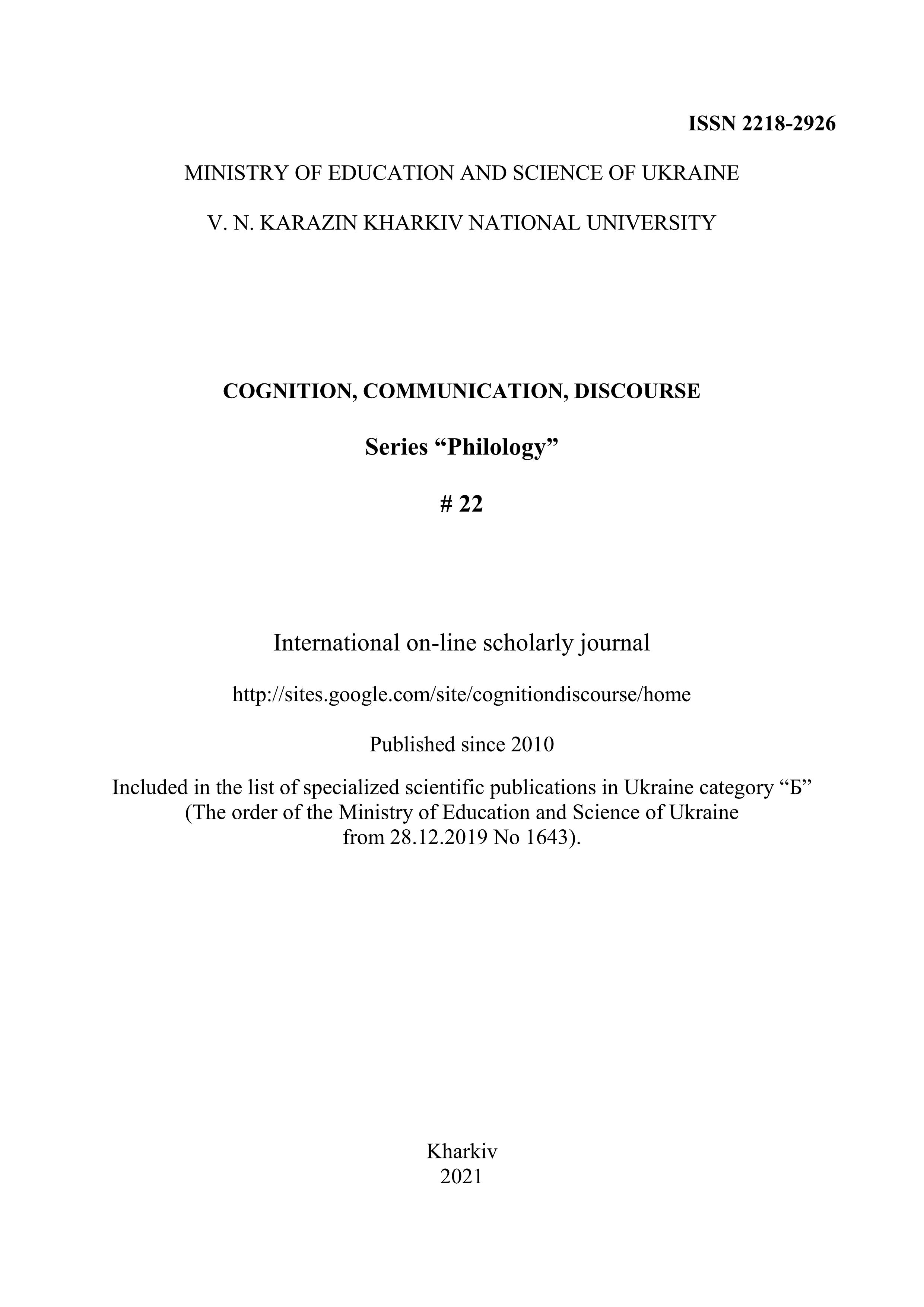Функції геральдичних символів в англомовній художній літературі
Анотація
В статті розглядаються основні функції, які виконують геральдичні символи, через їхню вербалізацію в блазонах як описах гербів специфічним набором мовних конструктів. Геральдичні символи як квінтесенція культури аналізуються в комунікативно-функціональному аспекті. Виділяються деякі особливі характеристики геральдичних символічних одиниць, а саме, їхня поліфункціональна спрямованість, здатність до множинності інтерпретацій, наявність механізму позначення та ін. Медіативна та мнемонічна функції символів, взяті з робіт Лотмана, проявляються в геральдичних символах художньої літератури як один з механізмів пам’яті культури, отже, символ є посередником сфер семіозису. Перелік функцій доповнюється розглядом соціального виміру, оскільки геральдичні символи потенціюються саме в соціумі, отже, розкривається сутність ідентифікаційно-інтегративної та адаптивно-регулятивної функцій геральдичної символіки. До аналізу блазонів на матеріалі англомовної художньої літератури залучаються поняття мультимодальної образності та синестезійного ефекту, які реалізуються у взаємодії вербальних та невербальних символів. Тема функціонування символів доповнюється класифікуванням основних функцій та підфункцій, запропонованих автором. У фокусі дослідження перебуває також ідентифікаційна функція, в результаті чого робиться акцент на роль особливої геральдичної мови у вираженні персони. З урахуванням типів гербів кодувальна функція розглядається в промовистих та алюзивних гербах, а також в геральдичних лексемах, запозичених з інших мов. Наскрізна ідея статті розкривається через інтерпретацію геральдичних символів у їхньому функціонуванні в творах англомовної художньої прози та поезії і підсумовується у визначенні символу не тільки як лінгвістичної одиниці, а і як семіотичного феномену культури.
Завантаження
Посилання
Aslamazishvili, D. N. (2007). Rol’ simvola v dukhovnykh protsessakh kul’turnogo perekhoda. [The role of symbol in the spiritual processes of cultural transference]. Unpublished candidate dissertation, Syberian aerospace academy, Krasnoyarsk, Russia (in Russian)
Averintsev, S. S. (2001). Sophia-Logos (2nd ed.) Кyiv: Dukh i Litera.
Barden, N., & Williams. Т. (2007). Words and symbols: language and communication in therapy. London: Open University Press.
Bortnik, O. I., & Rezko, I. V. (2008). Geral’dika mira [Heraldry of the world]. Minsk: Kharvest.
Chandler, D. (2007). Semiotics: the basics. London, New York: Routledge.
Egbert, J., Burch, B., & Biber, D. (2020). Lexical dispersion and corpus design. International Journal of Corpus Linguistics 25(1), 89–115. https://doi.org/10.1075/ijcl.18010.egb
Fernández, J. J., Eigmüller, M., & Börner, S. (2016). Domestic transnationalism and
the formation of pro-European sentiments. European Union Politics, 17, 457–81. https://doi.org/10.1515/9783110627275-007
Fox-Davies, A.C. (2007). A Complete Guide to Heraldry. New York, N.Y.: Skyhorse Publishing.
Hardy, M. (2018). The Shields that Guard the Realms of Men: Heraldry in Game of Thrones. Genealogy, 2(4), 48. https://doi.org/10.3390/genealogy2040048
Karmadonov, O. A. (1998). Semantika politicheskogo prostranstva: opyt krosskul’turnogo transsimvolicheskogo analiza [Semantics of political space: the experience of cross-cultural transsymbolic analysis]. Zhurnal sociologii i social’noj antropologii, 1(4), 34-39.
Kretov, P. V. (2000). Hnoseolohichnyi aspect filosofs’koho symvolizmu [The gnoseological aspect of philosophic symbolism]. Unpublished candidate dissertation thesis, South Ukrainian National Pedagogic University named after K. D. Ushynsky, Odessa, Ukraine (in Ukrainian)
Losev, A. F. (1995). Problema simvola i realisticheskoe iskusstvo [The problem of symbol and realistic art]. Moskva: Iskusstvo.
Lotman, Iu. M. (2001). Semiosfera [Semiosphere]. Sankt-Peterburg: Iskusstvo.
Meyer, L. (2020). Family History: Fact versus Fiction. Genealogy, 4(2), 44. https://doi.org/10.3390/genealogy4020044
Pimbley, A. F. (n.d.). Dictionary of heraldry. http://www.luz-herald.net/free/lettres.html
Sebeok, Th. A. (2001). Signs: An introduction to semiotics (2d ed.). Toronto, Buffalo, London: University of Toronto Press.
Shaw, E. (2020). “Who we are and why we do it”: A demographic overview and the cited motivations of Australian family historians. Journal of Family History, 45, 109–24. https://doi.org/10.1177/0363199019880238
Shevchenko, I. S. (2019). Enactive meaning-making in the discourse of theatre and film. Cognition, communication, discourse, 19, 15-19. DOI: 10.26565/2218-2926-2019-19-01
Shevchenko, I. (2017). Had We Never Loved So Kindly: Conceptualisation of communicative behavior. In E. Chrzanowska-Kluczewska, & O. Vorobyova (Eds.) Language – Literature – the Arts: A Cognitive-Semiotic Interface. Series: Text – meaning – context: Cracow Studies in English Language, Literature and Culture. (pp. 307-320). Frankfurt-am-mein: Peter Lang. https://doi.org/10.3726/b10692
Torop, P. (2019). The textual issues of meaning-making in theatre and film: a semiotic introduction. Cognition, communication, discourse, 19, 20-28. https://doi.org/10.26565/2218-2926-2019-19-02
Wade, W. C. (1989). The Symbolisms of Heraldry. London: George Redway.
Авторське право (c) 2021 Мойсеюк Юлія

Цю роботу ліцензовано за Міжнародня ліцензія Creative Commons Attribution-NonCommercial-NoDerivatives 4.0.
Автори, які публікуються у цьому журналі, погоджуються з наступними умовами:
Автори залишають за собою право на авторство своєї роботи та передають журналу право першої публікації цієї роботи на умовах ліцензії Creative Commons Attribution License (CC BY), яка дозволяє іншим особам вільно розповсюджувати опубліковану роботу з обов'язковим посиланням на авторів оригінальної роботи та першу публікацію роботи у цьому журналі.
Автори мають право укладати самостійні додаткові угоди щодо неексклюзивного розповсюдження роботи у тому вигляді, в якому вона була опублікована цим журналом (наприклад, розміщувати роботу в електронному сховищі установи або публікувати у складі монографії), за умови збереження посилання на першу публікацію роботи у цьому журналі.
Політика журналу дозволяє і заохочує розміщення авторами в мережі Інтернет (наприклад, у сховищах установ або на особистих веб-сайтах) рукопису роботи, як до подання цього рукопису до редакції, так і під час його редакційного опрацювання, оскільки це сприяє виникненню продуктивної наукової дискусії та позитивно позначається на оперативності та динаміці цитування опублікованої роботи (див. The Effect of Open Access).




